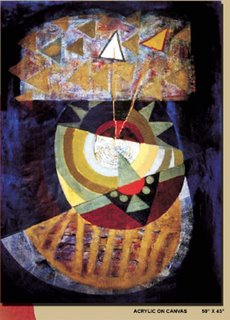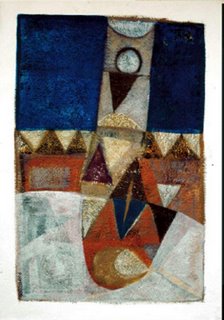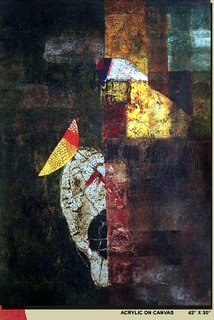narendra pal singh's Panchatattva
narendra pal singh's Panchatattva
by Vedprakash bhardwaj




There are a lot of young painters in India who are in search of right identity, but quite a few are able to carve a niche for themselves in this world of cut-throat competition. Narendra Pal Singh is one of them. Born in a small village in 1963, he is settled in Delhi. In fact, right through his every exhibition, his creativity and credibility comes to the fore. Being a Bachelor in Fine Art, he could have turned out to be a great believer in fine technique of his artistic training. But the artistic soul and mind in him revealed that art is not only fusion of skill and technique in swirl of colour, but more important, it is the expression of mundane experiences of life’s primeval love and affection.Even after moving over to the national capital, Delhi, Narendra Pal Singh is very much tied to his roots and traditional influences. His native state of Bihar still haunts and beckons him. Art critic and admirer call him as an odd man out in the crowd and also an oddity in vibrant art market. Without shunning principles of market economy, he has maintained a fair bit of gravity and thus commands a great market in India and abroad.
For me, it was 1993, which turned out to the maiden meeting with him and it took me no time to notice gradual rise of striking attraction in his works. Over the years, he went on to hone his brush skill on canvas. In his early life, he was inclined to figurative form of creation, but slowly and steadily he drifted in the world of abstraction. But he still denies any such drift from figure to abstraction in his work. In his view, abstraction is inherent part of his creation right from the very beginning. He said, “ In the beginning, I am to paint monkey series, which is out and out abstraction. I draw two different circle-small and big. Now which one is figure and which one is abstraction poses a question. In fact, I have flair for depicting my surrounding with a subtle touch of difference. For instance, a tree depicted in all other colour but green. Don’t you observe our folk and tribal art showing symbols and motifs of culture and mythology splashed in colour borrowed from fantasy world and in the course of entire process of decoration and embellishments, the very symbol, form, composition, line, shape and motif undergo gradual transformation from figure to abstract.
Nature is central to his art. In addition to natural impressions in his figure and abstraction, he also brings a fair element of folklore. Uma Nair, noted art critic once observed, “Imagine an artist who love folklore, and inhabits the hamlets of rural dusty India and watches the contemporary Indian women who partakes of the globalization frenzy and still hangs onto rituals and customs of the yesteryear. Narnedra Pal Singh is all of that and a little more because into his singular observations of the myths and reality of today’s world, he encapsulates the irony of being caught in a time warp”.In fact, sense of commitment and dedication to his ritualistic upbringing persuades him to avoid experimentation with Kitsch art. A serious look at his repertoire reveals a perfect blend of past and present, rural and urban sensibilities just as localization meets globalisation in his journey from form to abstraction.One of his most famous series, La Dolce Vita (The Sweet Life)- inspired by legendary filmmaker Fellini’s The Clowns received rave reviews. Unforgettable are his indigenous impressions from Western clowns, entirely with touch of things and moods Indian. Not only combination of colours and bold lines, range of unique motif in subtle sense inspire awe among viewers. Clowns funny in disposition and full of myriad emotions and sentiments bring alive childhood sentiments to the fore. In his recent series based on Mahabharata, there are a great deal of abstractionist situations.
Mahabharata being not only a story and great narrative of human life finds touching impression in his brushworks. After mahabharata he is painting Venice. Last year he visit Italy where his work exhibited. He returns from Italy with full of new ideas and start to paint Italy. In his new paintings he paint Italy in abstraction. But very soon, italys hangover is over and narendra tourn to panchtattva. He says `After my exhibition “Drishtikon” in which I ventured into the abstracted genre it is as if I have arrived at a testing ground for departure - a departure that is born out of the knowledge of destruction that seems rampant and widespread. All around me I see the destruction of all those elements of the Panchatattva - the signs of several parallel processes of gestation, birth, and inevitable destruction - a certain process by which various carnal impulses are translated into images, everywhere: I see hands strangely disembodied in a box of consumerist wants; maquettes of filth and garbage, plastic and construction material used for mega malls strewn about in varying degrees of composition; steel and iron, stone and marble, rope and cement all contend with each other in a discreet warfare of cut-throat consumerism.’
His current exhibition ‘panchatattava’ presented by gallery alternatives at shredharani art gallery, new delhi from july 19 to july 28 and after that exhibition will be shift at gallery alternatives, a22/8 dlf city phese-1, gurgaon.

0 Comments:
Post a Comment
<< Home